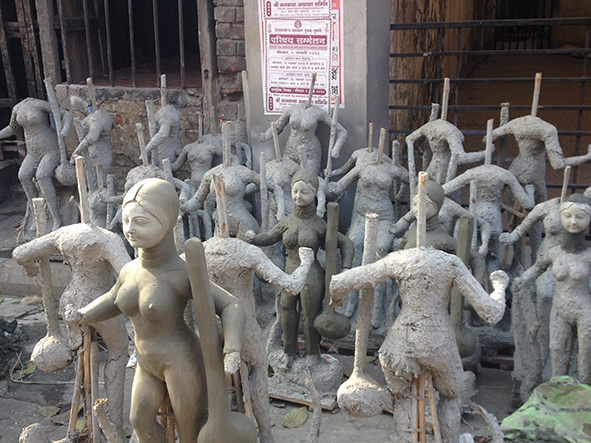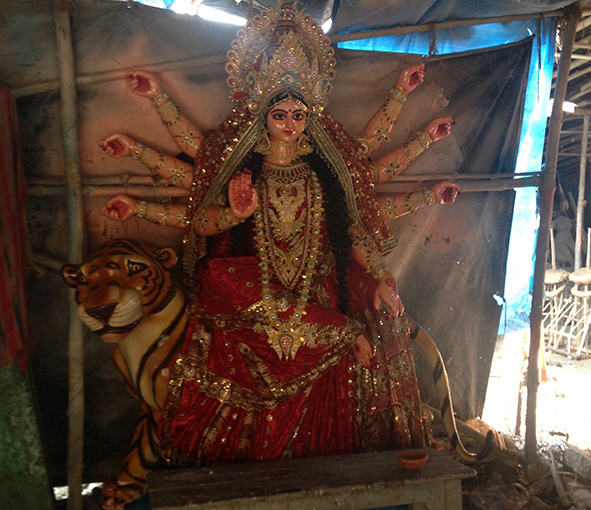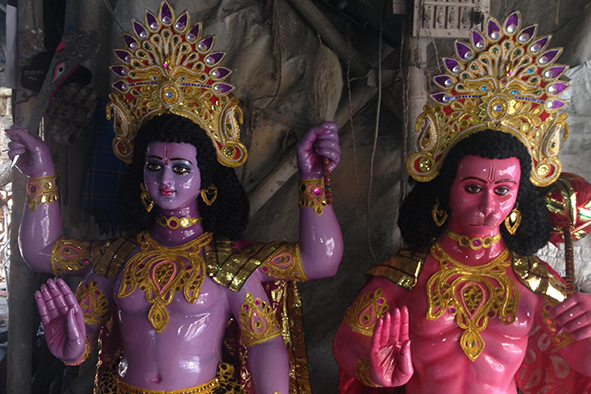In the enthralling historic quarter of Kumartuli in Kolkata, potters create lavish idols of deities for religious festivals. Its winding lanes are home to an artistic community that carry on a centuries-old tradition.
The gaudy yet fearsome figure of the Goddess Durga looms before me, resplendent in scarlet and gold. She raises a hand imperiously, her black hair tumbles down over her seven other extended arms as she straddles a Bengali tiger. This regal hauteur is at odds with her surroundings; a humble shanty workshop with dusty tables strewn with tools and pots of paint. The floor is scattered with straw that crackles beneath my feet and only a sheet of tarpaulin covers the slender wooden beams overhead.
It is the early hours of a pleasant morning in North Kolkata, and the sun casts a welcome light upon the labyrinthine streets of Kumartuli. I had made an early start, keen to escape from the chaotic noise and crowds of the city’s urban sprawl to explore these historic streets. It is here in these narrow lanes that potters diligently hand craft sumptuous idols of Hindu gods for a myriad of religious festivals. So far, it hadn’t disappointed.
Effigies
Beside the imposing effigy of Durga before me, other deities and antagonistic demons are in contrasting states of creation. Headless torsos composed of straw frames mingle with grey clay-coated statues, whose lotus shaped eyes appear almost quizzical as they await skilful hands to transform them into colourful divinities.
I emerge from the shed, nearly stumbling over a crouching potbellied elephant soon to be fashioned into Durga’s son Lord Ganesh. Before me, the winding Banamali Sarker Lane is filled with more ramshackle workshops flanked by countless grinning idols.
It is fascinating to discover the work of the artisans who carry on the area’s 300-year-old tradition of craftsmanship. Following the British colonisation of Bengal in the eighteenth century and the creation of the settlement that would become the teeming metropolis of Kolkata, workers in various industries were allocated quarters. These warrens soon became identified with the activity carried out within them. For example, in Bengali “kumar” means “to sculpt or shape” and “tuli” means place.
Today only the names of other districts in North Kolkata serve as remnants of the trade once plied by artisans such as wine makers, oil men, carpenters and cowherds. As competition mounted from the tradesmen of the Burrabazaar or the wholesale market that sprang up in Central Kolkata in the nineteenth century, many were forced to disperse and try their luck elsewhere.
But in Kumartuli, the potters have weathered the storms of economic change, giving rise to generations trained in the craft of idol making. Some can reportedly trace their family history back to before the foundation of the city itself in 1757. Initially, they shaped clay pots, toys and cooking utensils before moving onto the more lucrative business of creating lavish sculptures for the mansions of Indian aristocrats and local festivals or pujas.
Supply and Demand
Today Kumartuli is home to a community of more than 400 artisans who churn out thousands of clay effigies of the Goddess Durga, her children and asuras or demons. The figures are made from straw, bamboo and entel maati, a type of clay gathered from the banks of the River Hooghly that runs parallel to the district.
In addition to supplying India’s festivals, the effigies are exported every year to about 90 countries for religious events around the world. Most are created by anonymous artisans who toil long hours in their cramped workshops. But some do achieve a degree of fame; every year during festival season crowds rush to see the statues created by renowned veteran artisan Ramesh Chandra Pal.
The best time to visit Kumartuli and discover the captivating world of idol making is between June and January. The area is abuzz with activity in the run up to the biggest festival of all, the Durga Puja in October. During the pomp and pageantry of the festival, effigies of the Goddess are submerged in the River Hooghly. I imagine that many artisans who work painstakingly on these vibrant idols must feel a touch rueful when they see the fruits of their labour disappear beneath the surface of the water. In November the figures are reclaimed from the river banks and sent back to Kumartuli to be refurbished in a bid to restore them to their former glory.
Today is a relatively quiet day in the lanes. I pass an artisan as he methodically adds some finishing touches to the gruesome features of the sinister Lord Mahishasur, a buffalo demon vanquished by Durga. He chats amiably to his companion who sits crosslegged on a stool beside him. They pay me little heed apart from a cursory nod, by now used to the curious gaze of tourists. I get the sense they are savouring these moments of calm before the frantic build up to West Bengal’s biggest festival season gathers pace once more.
The air is heavy with the aroma of clay intermingled with the pungent waft of cooking, a reminder that Kumartuli is also the home of around 150 families who live in the crowded tenements alongside the workshops. The streets offer many vignettes of daily life; children scuttle at high speed through the alleyways playing hide-and-seek. An old man settles on a stool and pours water from a rusty tin bucket to begin a morning ritual of washing and scrubbing. Women in bright saris drape an assortment of clothes across makeshift washing lines which soon begin to billow in the gentle breeze that blows in from the river.
Snapshots of a city
A wander through Kumartuli offers an engrossing insight into the city’s artistic heritage. But be warned, the area also bears the signs of poverty and squalor that continues to plague, and in many Western minds, define Kolkata. The maze of lanes offers a curious image juxtaposing the sacred and the profane as pieces of rubbish and plastic dot the ground alongside the flamboyant effigies. A skeletal cat forages through one pile of garbage hopefully before disdainfully moving on in search of more promising fare.
Glamorous Bollywood stars advertising face cream and soft drinks peer blankly down from faded and peeling posters on the street walls. The dingy, unkempt state of the lanes reflect the ongoing battle of its inhabitants to force the Government to fulfil its promise of funding for modern housing along with improvements to its more than 500 workshops. The suggestion of a community art studio has also been mooted but has yet to materialise.
From the winding paths of Kumartuli, you can access the river banks of the mighty River Hooghly. Here, a very different type of awe inspiring sight awaits. The crumbling gothic mansions of the British Raj and the Bengali gentry overlook the river and echo the faded grandeur of the city’s past. It is hard not to draw the comparison between the demise of this opulent lifestyle and the survival of the creative community of Kumartuli.
The city may be gradually moving on from its sole identification with impoverishment and desperation; the south of the city is emblematic of a more modern, confident West Bengal with its shopping malls and apartment complexes. But the existence and work of the potters of Kumartuli is testament to the endurance of a rich cultural tradition which despite adverse conditions, continues to thrive.




